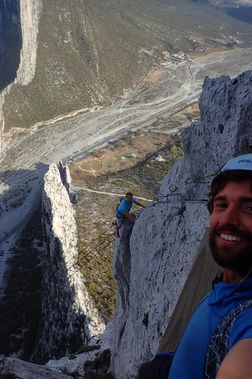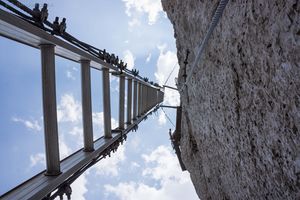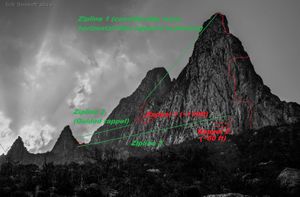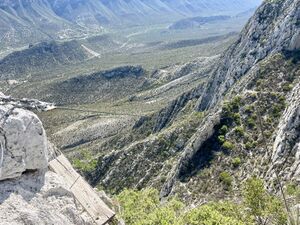Ruta Vertigo Via Ferrata
| Rating: | ||||||||||||
|---|---|---|---|---|---|---|---|---|---|---|---|---|
| | Difficulty:Via Ferrata 4A III (v4a1 III) Raps:3, max ↨145ft
Red Tape: Shuttle: | |||||||||||
| Location: | ||||||||||||
| Condition Reports: | 5 Apr 2024
"After many years, returned to do Ruta Vertigo! Mauricio gave us the beta on the route, since he had done it just a week before. He suggested the rock |
|||||||||||
| Best season: | ||||||||||||
| Regions: | ||||||||||||
Introduction[edit]
This is an amazing Via Ferrata, one of the longest that exist in Mexico.
Approach[edit]
Park in the community just off the paved road. In recent years there has usually been a police car parked here -- tell the officers (in Spanish) that you are there to climb the via ferrata, and ask if it is okay to leave your car(s). From the parking area hike through the little village up the dirt road to a small abandoned overlook building. From there a trail leads up to the base of the wall, at a low saddle in the rocky fin above you.
.*** The bottom 25 feet of the ferrata has been intentionally removed *** A locked ladder is used by the commercial guides to access the ferrata. The best way to get up to the lower rungs is to tie a thin cord around a rock or other object with some weight, and throw it up so that it loops around a rung. Use this cord to pull up a rope suitable for ascending. We bought 15m of cloth cord at a hardware store beforehand, and after many throw attempts by a couple people in the group, finally got a rope around the bottom rung.
The climbing grade is around 5.9, and there used to be three bolts available for quickdraws, but these have been chopped as of Apr 2024. Therefore if you are not comfortable lead-climbing 5.9 without any protection (most people aren't), use the rock-and-string method described above.
Once the rope is up, everyone else will have to ascend up to the first rungs, so bring ascenders. You can rock climb with a top belay but without climbing shoes doing the climb is difficult.
Descent[edit]
You will ascend by climbing rocks and metal rungs all the way to the top of a 1800ft rock fin. You will negotiate dropoffs, spooky traverses, and a crazy 60ft aluminum ladder suspended over hundreds of feet of air. The wind can be howling on the route and often is.
About halfway up the via ferrata, you will reach the point where the tibetan bridge was removed. You can tell this because the rungs abruptly end, and looking to your left you see them resume on the other side of a 30' gap. From here, you will need to rock climb up to where you can resume the metal rungs, which is about 50' up. The climbing grade is about 5.5 but exposed, and there are two bolts w/ hangars along the way for protection, along with a third double bolt anchor at the top. Sometimes there is a rope here but you should not fully trust this (as with any rope you come across) and belay the first person with your own rope until they reach the top and can set up a top belay. Bringing a couple quickdraws for clipping into the hangers would be useful, or just use carabiners to do so.
Via ferrata Deproach:
After you reach the top of the via ferrata, you will have to climb back down it. This is not particularly difficult to do, but there are steep sections on rock with only the safety cable and no rungs that are trickier to negotiate than when going up. At the site of the previous tibetan bridge, you'll need to rappel down the climb and recover your rope afterward. It is a good idea to bring an extra mallion to put around a hanger for the rope pull, along with some cord or webbing to leave behind to link the two bolts for redundancy.
Rappel Deproach:
If you prefer, the side of the mountain with the ziplines is a vertical wall that can be rappelled in multiple stages. It's scary, and can be difficult finding the anchor stations. Do not use the most decrepit rappel stations, i.e. the ones with railroad nails instead of pitons and barbwire loops instead of rappel rings. But depending on how you break up the rappels you might not have much of a choice.
Make sure you tie a big knot at the end of the rope before going down, and that as soon as you find the next station you tie the end of the rope to a bolt to avoid others to rappel off the end of the rope by mistake. Honestly it is more fun and safer just to downclimb the via ferrata.
Zipline Deproach (not currently possible due to zipline cables not tensioned):
Once at the top, if you brought a metal zipline trolley (such as the Petzl Tandem) for each person and know how to use them you may run the three long ziplines that zigzag down from the peak you just climbed. Be sure to use trolleys with steel and not aluminum rollers -- we had a brand new aluminum roller trolley disintegrate on the steel cable. You can also rent these from the rock climbing gym in Monterrey for around 400 pesos (check before your trip to see how many they have available, and they likely will only speak Spanish with you).
There are three ziplines. The 1st and 3rd are both about 200m long. The 2nd is not a zipline per say but more of a guided rappel using the cable along with rappelling on your own rope. For the 3rd zipline in particular ensure that you have a brake lanyard (sling + carabiner) or equivalent. You will likely not need to brake on the 1st zipline, but you will almost certainly need to do so on the 3rd (see detailed notes on braking below).
After the first zipline, there is a little more via ferrata and then a trail. From the bottom of the trail you will rappel down to the station for the second zipline -- this rappel is 130'.
.***PLEASE NOTE*** The second zipline cable is meant to be used by lowering each person on rope using the cable as a guideline. It is TOO STEEP to be ziplined freely. NOTE: 220ft of rope IS NOT ENOUGH. You will need around 250ft or more (exact length unknown). Either skip this zipline altogether and have everyone rappel from the station, or you can lower with two shorter ropes tied together. Regardless, the final person will need to rappel; the drop is 145' from the station. A fatality occurred on this zipline by someone trying to descend it with too short of a rope, and he ziplined the remaining distance. He crashed at high speed into the anchor at the bottom and died.
You can do the 3rd zipline but be warned (yet again) about the need for serious braking. If you do this zipline, you will end up on a final bit of via ferrata rungs that end approximately 115' above the ground, and you will need to rappel from here as well. Alternatively, you can skip the 3rd zipline altogether and just walk from the bottom of the 2nd zipline down the hillside to your car.
BRAKING: Note that using a steel carabiner on the steel cable does not really provide any friction; you will want an aluminum carabiner that will be heavily worn due to the braking and need to be disposed of afterward. Alternatively, some locals wear a thick leather work glove and reach up to grab the cable and slow themselves, but this is quite scary to do in practice when you are whizzing along and you risk *extreme* injury to your hand. Another option is to use a leather belt looped around the cable and attached to your harness with a spare via ferrata lanyard biner; pull down on this to slow. Be sure that the belt is made of genuine leather -- fake leather belts will instantly rip in two and not provide any braking. The first person is in greatest need of braking -- for the rest you should leave someone on the platform to catch anyone with excess speed, and/or push a backpack on a trolley out on the cable that they can crash into and slow themselves. Depending on wind conditions, you may not need any braking, or be in dire need of it.
Video showing different stages of the via ferrata
Zipline cable sag (Apr 2024)
Exit[edit]
Once safely back on firm ground hike back to your vehicle.
Red tape[edit]
This via ferrata was built by a commercial company using public money on public land and therefore accessible for use by the public. If you are not experienced enough to run the ferrata on your own you can hire a local company to guide you. Many adventure companies in Monterrey can lead you. Here are a couple examples:
Beta sites[edit]
Trip reports and media[edit]
- Facebook Album - Luca Chiarabini
- Facebook Album - Erik Bernhoft
 Wikiloc.com : Via Ferrata Huasteca Nuevo Leon
Wikiloc.com : Via Ferrata Huasteca Nuevo Leon Wikiloc.com : Vía Ferrata - Ruta Huasteca
Wikiloc.com : Vía Ferrata - Ruta Huasteca




